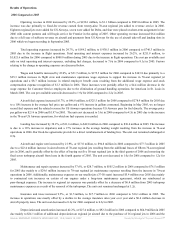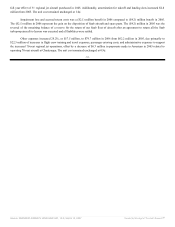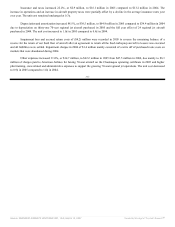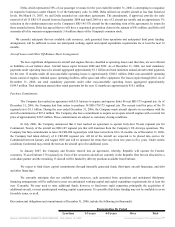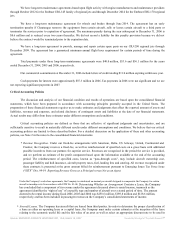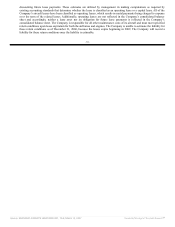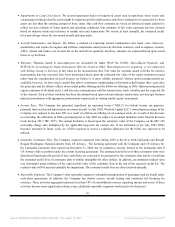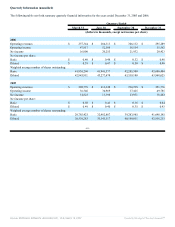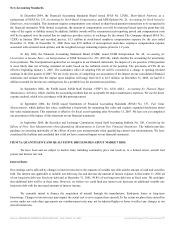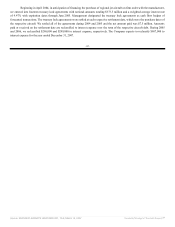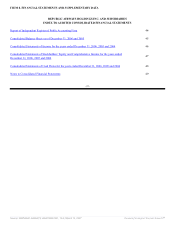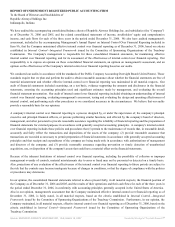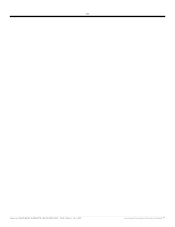Frontier Airlines 2006 Annual Report Download - page 70
Download and view the complete annual report
Please find page 70 of the 2006 Frontier Airlines annual report below. You can navigate through the pages in the report by either clicking on the pages listed below, or by using the keyword search tool below to find specific information within the annual report.
We have long-term maintenance agreements based upon flight activity with engine manufacturers and maintenance providers
through October 2012 for the Embraer ERJ-145 family of regional jets and through December 2014 for the Embraer ERJ-170 regional
jets.
We have a long-term maintenance agreement for wheels and brakes through June 2014. The agreement has an early
termination penalty if Chautauqua removes the equipment from certain aircraft, sells or leases certain aircraft to a third party or
terminates the services prior to expiration of agreement. The maximum penalty during the year subsequent to December 31, 2006 is
$0.6 million and is reduced every two years thereafter. We did not record a liability for this penalty provision because we did not
believe the contract would be terminated prior to the expiration date.
We have a long-term agreement to provide, manage and repair certain spare parts on our CRJ-200 regional jets through
December 2009. The agreement has a guaranteed minimum annual flight hour requirement for certain periods of time during the
agreement.
Total payments under these long-term maintenance agreements were $40.0 million, $53.6 and $56.1 million for the years
ended December 31, 2004, 2005 and 2006, respectively.
Our commercial commitments at December 31, 2006 include letters of credit totaling $11.0 million expiring within one year.
Cash payments for interest were approximately $87.3 million in 2006. Tax payments in 2006 were not significant and we are
not expecting significant payments in 2007.
Critical Accounting Policies
The discussion and analysis of our financial condition and results of operations are based upon the consolidated financial
statements, which have been prepared in accordance with accounting principles generally accepted in the United States. The
preparation of these financial statements requires us to make estimates and judgments that affect the reported amount of assets and
liabilities, revenues and expenses, and related disclosure of contingent assets and liabilities at the date of our financial statements.
Actual results may differ from these estimates under different assumptions and conditions.
Critical accounting policies are defined as those that are reflective of significant judgments and uncertainties, and are
sufficiently sensitive to result in materially different results under different assumptions and conditions. We believe that our critical
accounting policies are limited to those described below. For a detailed discussion on the application of these and other accounting
policies, see Note 2 in the notes to the consolidated financial statements.
• Revenue Recognition. Under our fixed-fee arrangements with American, Delta, US Airways, United, Continental and
Frontier, the Company receives a fixed-fee, as well as reimbursement of specified costs on a gross basis with additional
possible incentives from our partners for superior service. Revenues are recognized in the period the service is provided,
and we perform an estimate of the profit component based upon the information available at the end of the accounting
period. The reimbursement of specified costs, known as “pass-through costs”, may include aircraft ownership cost,
passenger liability and hull insurance, aircraft property taxes, fuel, landing fees and catering. All revenue recognized under
these contracts is presented at the gross amount billed for reimbursement pursuant to Emerging Issues Tax Force Issue
(“EITF”) No. 99-19 Reporting Revenue Gross as a Principal versus Net as an Agent.
Under the Company’s code-share agreements, the Company is reimbursed an amount per aircraft designed to compensate the Company for certain
aircraft ownership costs. In accordance with EITF No. 01-08, Determining Whether an Arrangement Contains a Lease, the Company
has concluded that a component of its revenue under the agreement discussed above is rental income, inasmuch as the
agreement identifies the “right of use” of a specific type and number of aircraft over a stated period of time. The amount
deemed to be rental income during fiscal 2006, 2005 and 2004 was $258.6 million, $189.8 million and $128.6 million,
respectively, and has been included in passenger revenue on the Company’s consolidated statements of income.
• Aircraft Leases. The Company has aircraft that are leased from third parties. In order to determine the proper classification of
a lease as either an operating lease or a capital lease, the Company must make certain estimates at the inception of the lease
relating to the economic useful life and the fair value of an asset as well as select an appropriate discount rate to be used in
Source: REPUBLIC AIRWAYS HOLDINGS INC, 10-K, March 15, 2007 Powered by Morningstar® Document Research℠




